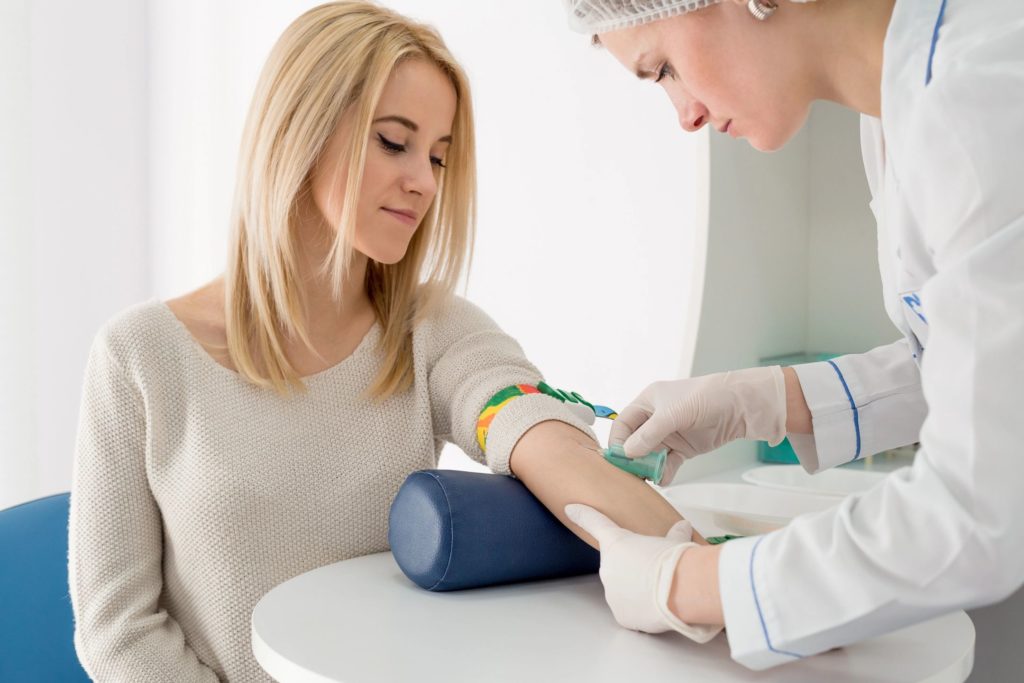IVF is an acronym for in vitro fertilization. It is a form of ART (assisted reproductive technology).
ART also incorporates procedures like IUI (intrauterine insemination) or Ovulation Induction (OI). However, IVF is arguably the most well known. IVF involves a combination of medication and office procedures at an IVF specialty center. Both medicine and procedures are necessary in order to help sperm fertilize an egg and ultimately help the fertilized egg implant into the uterus.
Let’s go through the full IVF process from start to finish.
IVF Process Start To Finish

Step 1: Initial Consult
The first step in the IVF process is scheduling an initial consult. Sometimes it may be wise to schedule more than one consult to get a second opinion. Sometimes this consult is covered by insurance or offered free by clinics.
During this consult, you will speak with your physician about what course of treatment is right for you given your medical and personal history. This consult can be done in person but is often done via phone or video if your clinic is not local. If you and your doctor decide IVF is the best course of treatment, your physician will schedule the next steps.
Step 2: Undergo Testing To Understand Your Current Baseline

The next step is to get your current ovarian reserve (or egg numbers) and hormones tested. This will allow us to better understand your current fertility situation and if there are any barriers to success. Baseline testing includes bloodwork and a transvaginal ultrasound.
Based on your initial number of follicles (potential eggs) and hormone levels, the physician will prescribe medications to grow the optimal amount of eggs. Next, you will give yourself the hormonal medications for 8 – 12 days while getting monitored regularly to make sure your follicles are growing at an optimal rate. Being monitored means that you go in for appointments to get an ultrasound and/or bloodwork taken. The doctor will then review your results, and you will receive a message in the afternoon letting you know if you should keep the same medication regimen or increase/decrease the dosage. The number and frequency of these visits depends on your clinic and how you are responding to the medications.
Traveling For Fertility Treatment?
If you are traveling for your treatment, you will go in for some monitoring appointments in your home city and likely travel to your destination on day 6 to 8 of your cycle. Clinics can electronically send your records and results so they can monitor you from afar. However, the time of day you take your medications may be impacted by how many time zones away you are from your clinic. You will continue your monitoring in your doctor’s clinic once you arrive to your destination until your egg retrieval.
Step 3: Egg Retrieval Procedure

Once your physician decides your follicles and hormone levels are optimal, you will self-administer a trigger shot. This trigger shot triggers ovulation so eggs can be retrieved.
You will be scheduled for the egg retrieval appointment at a very specific time and date. The retrieval process is painless, as you will likely be under some form of anesthetic during the procedure and you can go home the same day. To collect your eggs, your doctor will use a vaginal ultrasound to guide a very small needle into your ovary, through which your eggs can be withdrawn.
You will be told how many eggs were retrieved and viable within 48 hours. If you are doing egg freezing, your journey ends here.
*An important point to make here is: Only the eggs for that cycle will be removed. Undergoing an egg collection will not lower your total number of eggs for the future. This is a common question and not always explained by doctors. Every month a group of eggs is available for ovulation or collection. One will ovulate or release naturally, and the others get tossed out by the body, unless you collect them. This is one of the main reasons IVF and egg freezing are such successful treatments.
Step 4: Take The Eggs To The Lab To Be Fertilized
The eggs will then be taken into the lab at your clinic where they will be fertilized with sperm. Once an egg is successfully fertilized with sperm, it becomes an embryo. Based on discussions with your physician, you will have already decided if you will be performing genetic testing on the embryos or doing a fresh or frozen transfer.
- If you are doing a fresh transfer, the embryos will be grown for several days in the lab before they are likely transferred into your womb between day 3 – 6 based on the health of the embryos and several other factors unique to you.
- If you are doing genetic testing on the embryos to determine which are the most genetically competent, you will have to do a frozen transfer as it takes approximately 3 – 6 weeks to receive genetic testing results. Once the genetic testing results are back, you will discuss the results with your doctor. If you have multiple viable embryos, you will decide which are best to transfer. The transfer will likely be scheduled 1-2 months later. Remaining frozen embryos can stay frozen in storage and used at a later date for future children if desired.
- For either option, you’ll likely be taking medications that will support and thicken your endometrial lining. These medications are called progesterone and estrogen. They can be taken orally (pills), vaginally (suppositories or gel) or as an intramuscular injection. Your physician will discuss with you know which option is best for you, but injection is the most common.
Step 5: Embryo Transfer

Relative to the egg retrieval, the transfer procedure is easy. It is done without anesthesia and is an outpatient procedure, similar to a Pap smear in the office. The actual procedure takes about 10-20 minutes. The hardest part of an embryo transfer is having a very full bladder, which is important to help see the placement of the embryo catheter on ultrasound.
Once your embryo or embryos is transferred into your womb, the embryo will need to attach and implant into the endometrial lining in order to achieve the pregnancy. Patients often have a 10 – 14 day wait to find out if the embryo has implanted successfully, known to many as the “two week wait”. That is also when you will do a pregnancy test to confirm if the transfer is successful. Your physician will speak closely with you throughout the process.
Interested In A Fertility Consult?
Cayman Fertility Centre offers free consults to patients who would like to discuss their case with a Reproductive Endocrinologist. You can schedule a consult by contacting us here. Cayman Fertility Centre is a state of the art facility in one of the most luxurious places in the world. We look forward to hearing from you!
